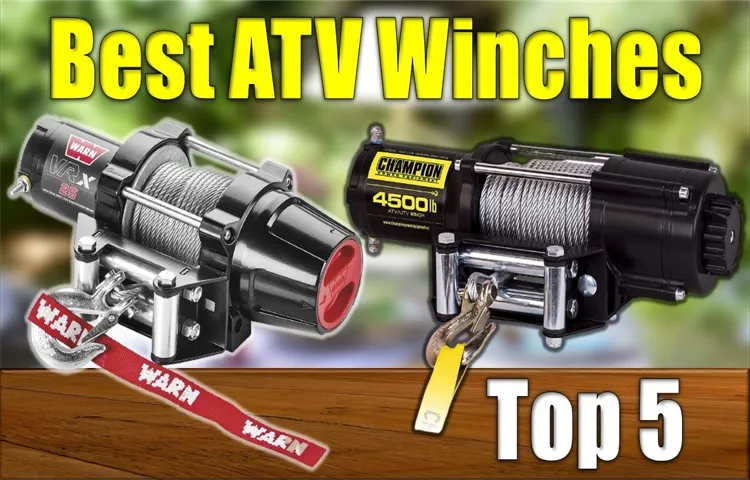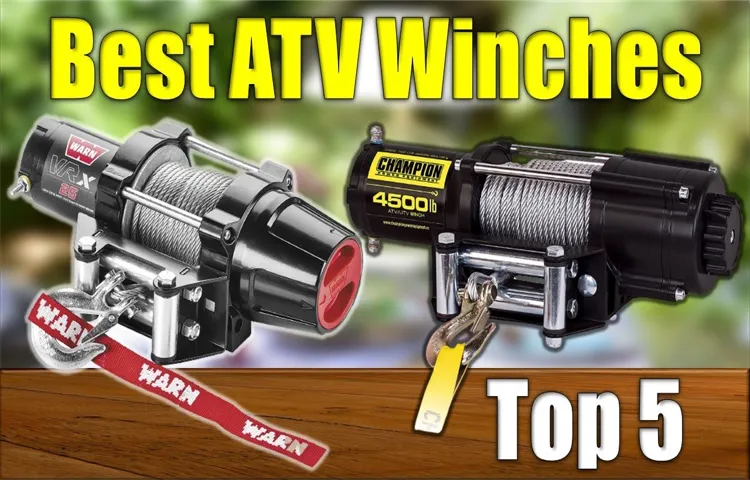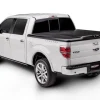Hey there! So, you’ve got an ATV and you’re looking to equip it with a winch. That’s a smart move! Whether you’re into off-roading, hunting, or just want a reliable tool for utility purposes, having a winch on your ATV can really come in handy. But with so many options on the market, how do you choose the right winch for your ATV? Well, that’s where I come in.
Let’s dive into the world of winches and figure out which one is the perfect fit for your off-road adventures.
Table of Contents
Understanding the Weight of Your ATV
When it comes to off-road adventures, having the right equipment is crucial for a safe and successful trip. If you’re planning to take your ATV on rugged terrain or use it for heavy-duty work, investing in a winch is a wise decision. But how do you know what size winch you need for your ATV? The weight of your ATV plays a significant role in determining the winch capacity you should choose.
To figure out the weight of your ATV, you can check your owner’s manual or contact the manufacturer directly. Once you have this information, you can match it to the appropriate winch capacity. A winch with a higher capacity than your ATV’s weight is recommended to ensure it can handle any unexpected situations that may arise.
So, next time you’re gearing up for an off-road adventure, make sure you have the right winch to support your ATV’s weight and handle any challenges that come your way.
Calculating the Weight of Your ATV
ATV weight can play a significant role in not only the performance and durability of your vehicle but also in how you use it. Understanding the weight of your ATV and why it matters is crucial for any ATV enthusiast or owner. When we talk about the weight of an ATV, we’re not just talking about how heavy it is overall.
We’re also talking about the distribution of that weight and how it impacts various aspects of your ATV’s performance. The weight of your ATV affects its stability, maneuverability, and ability to handle different terrain types. A lighter ATV may be more nimble and responsive, making it easier to navigate tight corners and rough trails.
On the other hand, a heavier ATV may provide better traction and stability, making it more suitable for hauling heavy loads or riding on more challenging terrain. Additionally, the weight of your ATV can impact its fuel efficiency and overall durability. An ATV that is too heavy for its frame or suspension may experience excessive wear and tear, leading to costly repairs or even safety issues down the line.
To calculate the weight of your ATV, you’ll need to consider several factors. These include the weight of the vehicle itself, any additional accessories or modifications, and the weight of the rider and any cargo. Keep in mind that the weight of an ATV can vary significantly depending on the make, model, and specific configuration.
It’s always a good idea to consult your ATV’s owner manual or contact the manufacturer to get accurate weight information. Understanding the weight of your ATV is crucial for ensuring safe and enjoyable riding experiences. By taking the time to calculate and consider the weight of your ATV, you can make informed decisions about how to best utilize and maintain your vehicle.
So, before you hit the trails, take a moment to give some thought to the weight of your ATV and how it may influence your riding experience.

Determining the Pulling Capacity of the Winch
ATV weight, pulling capacity, winch When it comes to using a winch on your ATV, it’s important to understand the weight of your vehicle. Why? Well, the pulling capacity of a winch is determined by the weight it can handle. Think of it like lifting weights at the gym.
Just as you wouldn’t try to lift a weight that is too heavy for you, you shouldn’t try to use a winch that isn’t capable of handling the weight of your ATV. To determine the weight of your ATV, you can consult the owner’s manual or look for a placard on the vehicle itself. This will give you a rough estimate of its weight.
Keep in mind that the weight can vary depending on the make and model, as well as any additional accessories or modifications you may have added. Once you have a good idea of the weight of your ATV, you can then look for a winch that has a pulling capacity that matches or exceeds that weight. For example, if your ATV weighs around 500 pounds, you’ll want to look for a winch that has a pulling capacity of at least 500 pounds or more.
Choosing a winch with the right pulling capacity is crucial for safety and effectiveness. If you use a winch that is too small for your ATV, it may not be able to handle the weight and could break or malfunction. On the other hand, if you use a winch that is too large for your ATV, it may be unnecessarily bulky and expensive.
So, take the time to understand the weight of your ATV before you invest in a winch. It’s a simple step that can make a big difference in your off-roading adventures. Don’t forget to consult your owner’s manual or look for a placard to get an accurate estimate of your ATV’s weight.
With the right winch, you’ll be able to tackle any terrain with confidence.
Considering the Usage and Terrain
When it comes to choosing a winch for your ATV, it’s essential to consider both the usage and terrain you’ll be encountering. The size of the winch you need will depend on the weight of your ATV and the type of activities you plan on using it for. If you mainly use your ATV for light trail riding or recreational purposes, a smaller winch with a lower pulling capacity may be sufficient.
However, if you frequently go off-roading or use your ATV for heavy-duty tasks like pulling your ATV out of mud or towing heavy loads, you’ll need a winch with a higher pulling capacity. Additionally, the terrain you’ll be traversing is another crucial factor to consider. If you often find yourself in challenging terrains like steep hills, deep mud, or rocky surfaces, you’ll need a winch with more power to handle these demanding conditions.
Ultimately, it’s important to assess your ATV’s needs and the types of environments you’ll be encountering to determine how much winch power you need for your ATV.
Assessing the Types of Terrain You Ride On
terrain, riding, types, assessing, usage, factors. Riding a bike is not just about the thrill of speed and the wind in your hair; it also involves navigating through different types of terrain. Whether you’re a casual rider or a seasoned cyclist, it’s important to assess the types of terrain you’ll be riding on to ensure a safe and enjoyable experience.
One of the key factors to consider is your usage. Are you planning on riding on paved roads, off-road trails, or a mix of both? Each type of terrain poses its own challenges and requires different skill sets. For example, paved roads offer a smooth and predictable surface, but you still need to be mindful of traffic and obstacles.
On the other hand, off-road trails can be more uneven and require greater control and balance. By considering your usage and the terrain you’ll be riding on, you can better prepare yourself and choose the appropriate bike and equipment for a successful ride.
Determining the Frequency of Winch Use
winch use frequency, Determine winch usage, assessing winch usage, winch usage on different terrains Determining the frequency of winch use is crucial in order to properly maintain and utilize this essential off-road tool. The usage and terrain play a significant role in determining how often the winch will be needed. If you frequently find yourself traversing treacherous terrains or tackling challenging off-road obstacles, the likelihood of requiring winch assistance is higher.
In these situations, the winch can be used to recover and rescue the vehicle from unforeseen situations such as getting stuck in mud or navigating through rocky terrain. Similarly, winch usage frequency can also depend on the individual’s off-road adventures frequency. Someone who regularly explores rough and rugged terrains will likely use their winch more frequently compared to someone who rarely ventures off the beaten path.
It’s important to consider the burstiness of winch usage as well. While there may be periods of frequent winch use during intense off-road excursions, there could also be long stretches where the winch is not needed at all. Assessing the terrain and frequency of off-road adventures will help to determine how often the winch should be used and serviced to ensure it is always ready for action.
Exploring Different Winch Options
When it comes to choosing the right winch for your ATV, there are a few factors to consider to ensure you get one that meets your needs. One of the most important things to consider is the pulling capacity of the winch. The pulling capacity is usually measured in pounds and determines how much weight the winch can safely pull.
To determine how much winch you need for your ATV, you should consider the weight of your vehicle plus any additional weight it may be carrying, such as gear or cargo. It’s also a good idea to consider the terrain you will be riding on and whether you will be using the winch for self-recovery or to help others. Additionally, you should consider the type of winch you want, such as electric or hydraulic, and any additional features you may need, such as a wireless remote control or a synthetic rope instead of a steel cable.
By taking these factors into consideration, you can ensure that you choose the right winch for your ATV.
Electric vs. Hydraulic Winches
electric vs. hydraulic winches, winch options
Wire Rope vs. Synthetic Rope
Exploring Different Winch Options: Wire Rope vs. Synthetic Rope When it comes to winching, choosing the right type of rope can make a world of difference. There are two main options to consider: wire rope and synthetic rope.
Let’s take a closer look at the pros and cons of each to help you decide which one is the best fit for your needs. Wire rope, made from strands of high-strength steel, has been the traditional choice for winching applications for many years. It’s extremely durable and can handle heavy loads without breaking.
However, wire rope is prone to kinking, which can weaken the rope and make it more difficult to spool. It also tends to corrode over time, especially if it’s exposed to saltwater or harsh weather conditions. On the plus side, wire rope is more resistant to abrasion and heat, which can be advantageous in certain circumstances.
On the other hand, synthetic rope, typically made from high-strength fibers like Dyneema or Spectra, has gained popularity in recent years. It offers several advantages over wire rope, including being lighter and easier to handle. Synthetic rope is also less prone to kinking and doesn’t require lubrication, making it more user-friendly.
It’s also UV resistant and doesn’t rust or corrode, making it ideal for outdoor use. However, synthetic rope is more susceptible to abrasion and can be damaged by sharp edges or rough surfaces. It’s also not as heat resistant as wire rope, so it may not be suitable for continuous heavy-duty winching.
So, which option is better? It really depends on your specific needs and preferences. If you’re looking for a rope that can handle heavy loads and abrasive conditions, wire rope may be the better choice. On the other hand, if you prioritize ease of use, lightweight design, and resistance to corrosion and UV exposure, synthetic rope may be the way to go.
Choosing the Right Size and Style
When it comes to choosing the right winch size and style for your needs, there are a few factors to consider. Firstly, you’ll want to determine the weight and size of the loads you’ll be regularly lifting or pulling. If you plan on using the winch for small tasks like hauling a boat onto a trailer, a smaller winch with a lower weight capacity may be sufficient.
However, if you’ll be dealing with heavy loads on a regular basis, such as pulling large vehicles out of ditches or moving equipment, a larger winch with a higher weight capacity will be necessary. In addition to weight capacity, the style of winch can also play a role in your decision-making process. There are various types of winches available, including electric winches, hydraulic winches, and manual winches.
Electric winches are popular for their ease of use and ability to be mounted on a variety of vehicles. Hydraulic winches, on the other hand, provide greater power and can handle heavier loads. Manual winches are a more budget-friendly option but require physical strength to operate.
Ultimately, the right winch size and style for you will depend on the specific tasks you’ll be performing and your budget. It’s important to carefully consider your needs and do some research to find the best winch for your requirements. By investing in the right winch, you can ensure that you have the power and capability to handle any lifting or pulling job that comes your way.
Installation and Maintenance Tips
When it comes to choosing the right winch for your ATV, it’s important to consider the weight and size of your vehicle. The size of the winch will determine how much pulling power it has, so it’s crucial to get one that is strong enough to handle the weight of your ATV. A general rule of thumb is to choose a winch that is rated for at least
5 times the weight of your ATV. For example, if your ATV weighs 500 pounds, you would want a winch rated for at least 750 pounds. This will ensure that the winch has enough power to safely pull your ATV out of any sticky situation.
Additionally, it’s important to consider the type of terrain you will be riding on. If you often find yourself in muddy or hilly conditions, you may want to invest in a winch with a higher pulling capacity. On the other hand, if you primarily ride on flat, dry surfaces, a winch with a lower pulling capacity may be sufficient.
Ultimately, the key is to choose a winch that matches the needs of your ATV and the conditions you will be riding in.
Installing the Winch on Your ATV
Installing a winch on your ATV can be a great addition for off-road adventures. Not only will it give you a way to pull yourself out of sticky situations, but it can also be handy for helping others in need. When it comes to installing the winch, there are a few tips to keep in mind to ensure a smooth installation process and ongoing maintenance.
First and foremost, it’s important to carefully read and follow the instructions provided by the winch manufacturer. Each winch may have slightly different installation requirements, so it’s crucial to familiarize yourself with the specific instructions for your model. This will help you avoid any unnecessary damage or mistakes during the installation process.
Before you start the installation, make sure you have all the necessary tools and equipment on hand. This may include a socket wrench, screwdrivers, and wire strippers. Having everything ready before you begin will save you time and frustration.
When it comes to mounting the winch, it’s important to choose a strong and secure location on your ATV. Typically, this will be on the front of the ATV, but always refer to the instructions for the recommended mounting location. Remember, the winch will be under a lot of strain when in use, so it’s crucial to ensure it is securely attached.
Once the winch is mounted, it’s important to properly wire it to your ATV’s battery. This may involve connecting the positive and negative wires, as well as any necessary control cables. Again, refer to the instructions for the specific wiring requirements for your winch.
In terms of maintenance, regularly inspect and clean your winch to keep it in optimal working condition. Check for any signs of wear or damage, and replace any worn-out parts as necessary. Additionally, make sure the winch is properly lubricated to ensure smooth operation.
Regular Maintenance and Inspection
Regular maintenance and inspection are essential for ensuring the proper functioning and longevity of any installation. Whether it’s a new appliance, a home plumbing system, or a car engine, regular maintenance is key to prevent breakdowns and costly repairs down the line. It’s like giving your car a regular oil change or going to the dentist for a check-up – by investing a little time and effort into maintenance, you can save yourself a lot of trouble in the long run.
Regularly inspecting your installations allows you to catch any potential issues early on before they become major problems. It’s better to fix a small leak or replace a worn-out part now than to deal with a burst pipe or a damaged engine later. So, don’t neglect regular maintenance and inspection – it’s an investment that pays off in the form of peace of mind and a hassle-free experience.
Conclusion
In the epic battle of man versus terrain, the humble ATV emerges as the noble steed, ready to conquer any obstacle in its path. But even the mightiest warrior needs a helping hand sometimes, which is where the trusty winch comes into play. Now, the amount of winch you need for your ATV is a delicate balance between practicality and sheer badassery.
You see, the winch is a tool that defies the laws of physics to pull you out of those sticky situations when the mud is deep and the hill is steep. Some might say that it’s not the size of the winch that matters, but how you use it. And while that may be true to some extent, there’s no denying that a generous helping of winch power can make all the difference in your off-roading escapades.
So, how much winch do you need for your ATV? Well, it all depends on your personal ambitions. Are you a daredevil, seeking to conquer the most treacherous terrains known to man? Then you’ll want a winch that could pull a locomotive out of a ditch. But if you’re more of a moderate adventurer, who occasionally finds themselves in a sticky situation, a more modest winch might suffice.
A winch that can handle the average mud pit, but won’t send you hurtling into the stratosphere with its power. Ultimately, the choice is yours. Whether you opt for an impressive winch that could rival the strength of Hercules, or a more humble helper that gets the job done without breaking a sweat, know that your ATV will thank you for having its back.
Remember, in the world of off-roading, there are no guarantees. Each adventure brings a new challenge, a new battle to be fought. And with the right winch by your side, you’ll have the confidence to overcome any obstacle and emerge victorious.
So, my fellow adventurers, don your helmets, strap on your seatbelts, and choose your winch wisely. For in the wild terrain that awaits, only the prepared shall prevail. Happy off-roading, and may the winch be ever in your favor.
FAQs
What is a winch and why do I need one for my ATV?
A winch is a device that allows you to pull or hoist heavy objects. You need a winch for your ATV to assist in situations such as getting unstuck from mud, snow, or other off-road terrain, as well as for pulling heavy objects or vehicles.
How do I determine the appropriate winch capacity for my ATV?
To determine the appropriate winch capacity for your ATV, you should consider the weight of your ATV, any additional equipment or accessories, and the types of activities you plan to engage in. Generally, it is recommended to choose a winch with a pulling capacity that is at least 1.5 times the weight of your ATV.
What are the different types of winches available for ATVs?
There are two main types of winches available for ATVs: electric winches and hydraulic winches. Electric winches are the most common and are powered by the vehicle’s battery. Hydraulic winches, on the other hand, are powered by the ATV’s hydraulic system and are typically more expensive but offer greater pulling power.
What are the essential features to look for in an ATV winch?
When selecting an ATV winch, it is important to consider features such as pulling capacity, line speed, durability, waterproof rating, and ease of installation. Some winches also offer additional features like wireless controls or synthetic rope instead of traditional steel cable.
Can I install a winch on my ATV myself or do I need professional help?
While installing a winch on your ATV generally requires basic mechanical skills, it is recommended to follow the manufacturer’s instructions or seek professional assistance for a proper and secure installation. This ensures the winch is mounted correctly and functions safely.
How can I maintain my ATV winch for optimal performance and longevity?
To maintain your ATV winch, regularly inspect the cables, electrical connections, and control switch for any signs of damage or wear. Lubricate the winch components according to the manufacturer’s recommendations and keep it clean from dirt, dust, and debris.
Are there any safety precautions I should take when using an ATV winch?
Yes, there are some safety precautions to follow when using an ATV winch. Always wear gloves and eye protection when operating the winch. Be cautious of the load capacity and never exceed the winch’s maximum pulling capacity. Avoid standing in the direct line of the winch cable or rope and keep bystanders at a safe distance. Also, be familiar with the winch controls and practice proper winching techniques.



